Bert Bauwens: Building Bridges Through the Green Entrepreneurship Committee
09/12/2025 - 08:39
What makes someone a great landscape gardener? A passion for greenery, a deep understanding of soil and plants, a keen eye for quality, and — of course — a healthy dose of East Flemish modesty. Meet Bert Bauwens from Waasmunster, Belgium. With 18 years of experience under his belt, Bert truly embodies the craft. In this candid conversation, he shares how it all began in his grandfather’s vegetable garden, why TerraCottem is his go-to choice for laying lawns, and why supporting fellow landscapers — even those considered competitors — matters deeply to him. Oh, and one more thing: Bert’s work will soon be admired from above, as he takes home the top prize in our drone competition!
| Interviewer: Davy Ottevaere |
Hi Bert, congratulations once again on winning our drone competition! Soon we’ll head out together to film the project of your choice. What are your plans for the video once it’s ready?
I’ll definitely share it on my social media. And of course, I’ll also put it on my website.
Do you often use social media?
I do have Facebook and Instagram accounts, but I rarely use them. Posting isn’t always straightforward either - some clients don’t want photos of their gardens shared online, especially if their homes are visible. Their privacy is very important, and I always respect that.
That said, I’m aware that potential new clients often check my profiles or website to see who I am. That’s why I also have a portfolio section on my website.
How do you find your clients?
Mostly through word-of-mouth. Personal recommendations are everything in our sector.
Most of my projects are local - close to home - and that already provides me with plenty of work. Every now and then, I take on a project further away, especially in Bruges where my wife is from, and recently even one in Knokke. But the majority of my work remains here in Waasmunster.
Sometimes I also sponsor local initiatives, partly out of sympathy, but also to create some extra brand awareness.
Let’s go back to the beginning, Bert: how did you become a landscaper? What made you choose this profession?
My grandfather loved the outdoors - he was a pigeon fancier and also kept a large vegetable garden. As a child, I often helped him. Around the same time, I had to make a choice at school. Subjects like French and economics weren’t really my thing. Because of my passion for gardening, I decided to attend the horticultural school in Sint-Niklaas, where I was lucky to have excellent, highly motivating teachers.

Do you mean this school: Broederschool Biotechnische & Sport?
Earlier this year I gave a talk there about ‘the soil and its acronyms’.
Yes, that’s right.
I was very happy at that school and I still have good contacts there. More than that: I often get interns from my old school who come and help me out.
| Read the blog post “The soil and its acronyms” here. |
|---|
 |
A small world. But I interrupted you — please carry on…
While I was at school, I also had to do a work placement. My placement was with Aster Tuinen. It was a fantastic experience. I could roll up my sleeves straight away. Not just ‘tidy up’ and ‘watch’, as interns often have to do. I was allowed to do all the operations, such as, for example, rotavating.
It went really well - Rik and Betty, the driving forces behind Aster Tuinen, were very pleased with my work. They even invited me back during the school holidays, and after graduation I was able to start there right away.
In the end I worked there for five years, but then Aster closed. I was only 23 at the time. I did consider taking over the business for a moment. But ultimately that step came just a little too soon for me - I was still too young.
I then worked for a few more years as an employee for another landscaping company. At first it was fun and challenging, but over time it became more of a routine: mostly pruning. I also felt ready to stand on my own two feet - that’s when I decided to take the leap and start working as a self-employed landscaper.
That was in 2006: by now I’ve been a landscape gardener for 18 years (laughs).
Great. You’ve already had quite a journey. Do you work alone or with a team?
 |
Tuinen Bert Bauwens is very much a one-man business. My father used to help as well, but he’s been retired for a while now. From time to time, I collaborate on specific projects with a close circle of trusted colleagues. For example, if a project includes a swimming pond, I’ll subcontract that part to a specialist I regularly work with. |
I’m proud that with most clients I can manage everything from A to Z. And I make sure it’s done properly - since I’m often the one who comes back later to take care of the garden maintenance as well (laughs).
I don’t doubt that. You say from A to Z: do you also design gardens yourself? I mean, do you do the drawings?
Clients can certainly come to me for design work. I draw the smaller projects myself. The somewhat larger ones I pass on to a landscape architect friend I often work with.
How many projects do you do in a year?
Oh, that’s difficult to answer. It really depends very much on the size of the projects, of course.
- I usually do one major project in spring and one in autumn. In between, in the summer, it’s mainly pruning work.
- Smaller projects might be three in spring, for example. But then we’re mostly talking about planting only.
Some projects also bring extra work, such as meetings that take up quite a bit of time. Right now, I’m working on a fairly large project in the centre of Ghent that includes a swimming pond. It also involves site meetings with the building contractor and others - mainly to make sure everything is well coordinated, so the different tasks fit together seamlessly.
I’d like to return to your time at horticultural school. As you may know, the National Grass Day in Belgium now includes a second day dedicated specifically to students. This year, more than 600 horticulture students attended—which is quite impressive.
That is indeed a lot, but to be honest: I’m not surprised.
And I hope that we also do our bit. By ‘we’ I mean the Commissie Groen Ondernemen VZW (Green Entrepreneurship Committee).
We’re a non-profit that aims to promote and professionalise the profession of landscape gardener. More specifically:
It used to be called ‘Commissie Groen Jong Ondernemen’ (Green Young Entrepreneurship Committee), but we’ve all got a bit older and we dropped the ‘young’ (laughs).
There are around ten of us on the board:
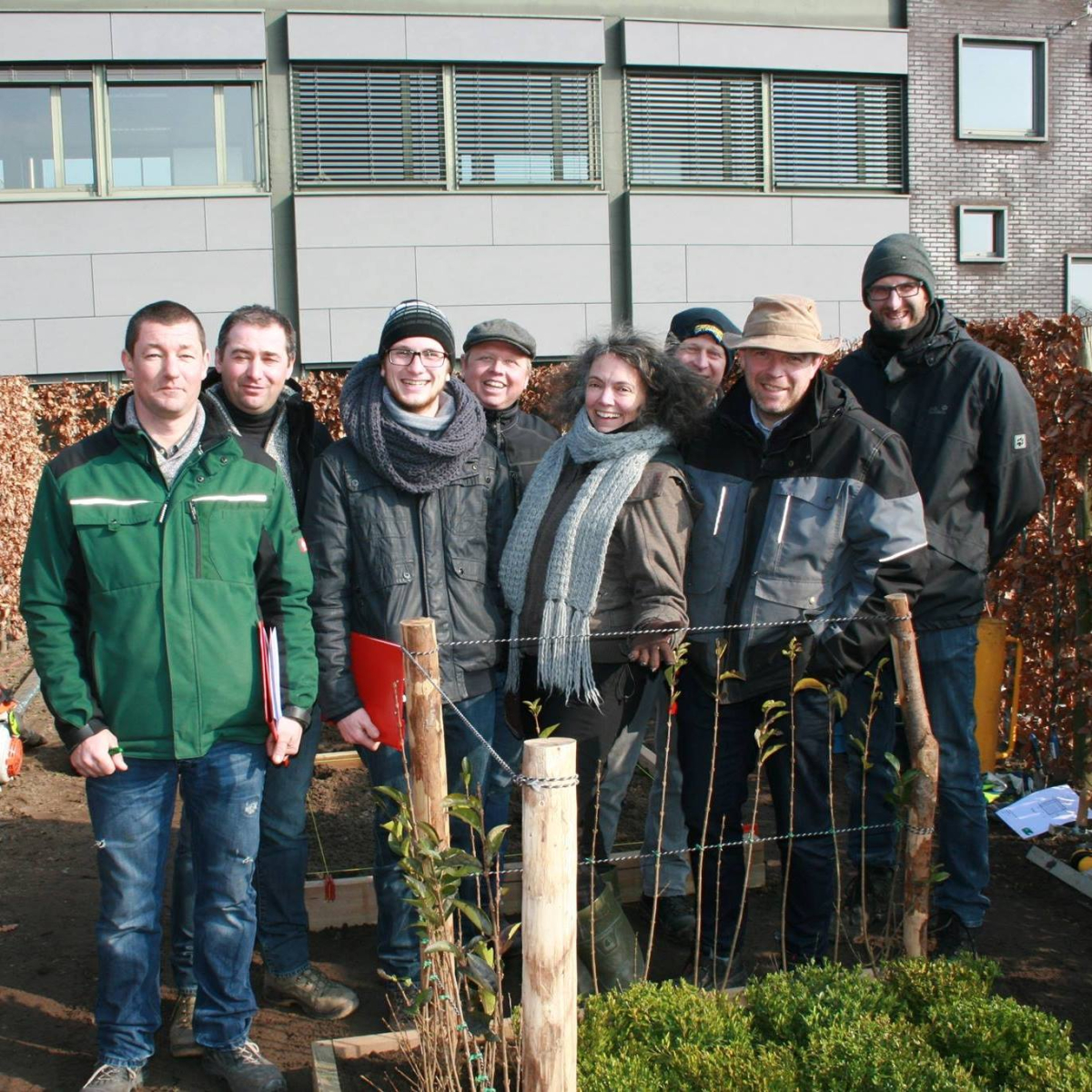
One of the things we do is organise the ‘Promising Gardener’ competition.
It’s a kind of skills competition, but specifically for horticultural schools. We do this together with the Belgische Federatie Groenvoorzieners (Belgian Federation of Landscaping Contractors) (BFG-FBEP), which recently changed its name into Pro4Green.
That sounds very interesting: can you tell us a bit more about this ‘Promising Gardener’?
Absolutely. The competition takes place in two phases:
- In spring we hold the pre-selections. These include both a practical and a plant identification test. A legacy of the COVID period - when practical tests weren’t possible - is the theoretical questions section. Those are still included. For example: ‘You have X m² of grass to sow: how many kilograms of grass seeds are needed?’
- After the pre-selections three schools are shortlisted and invited to the Tuindagen in het park van Beervelde (Garden Days at Beervelde Park), where they have to build a demo garden themselves.
The winner receives a trophy. And eternal fame (laughs).
Is that per school or are those individual pupils taking part?
Each school nominates three pupils to represent them. These don’t necessarily have to be the top students - some schools even draw lots to decide who goes. Others deliberately put together a mixed team: one student for the plant identification test, another for the practical assignment, and a third for the knowledge question
We find that this concept really lives among the schools. This year the competition ran for the 15th time and all 20 Flemish horticultural schools had registered.
And who was last year’s laureate?
In 2024 LTI Oedelem won. Second place went to PTI Kortrijk. And bronze to Wijnpers Leuven.
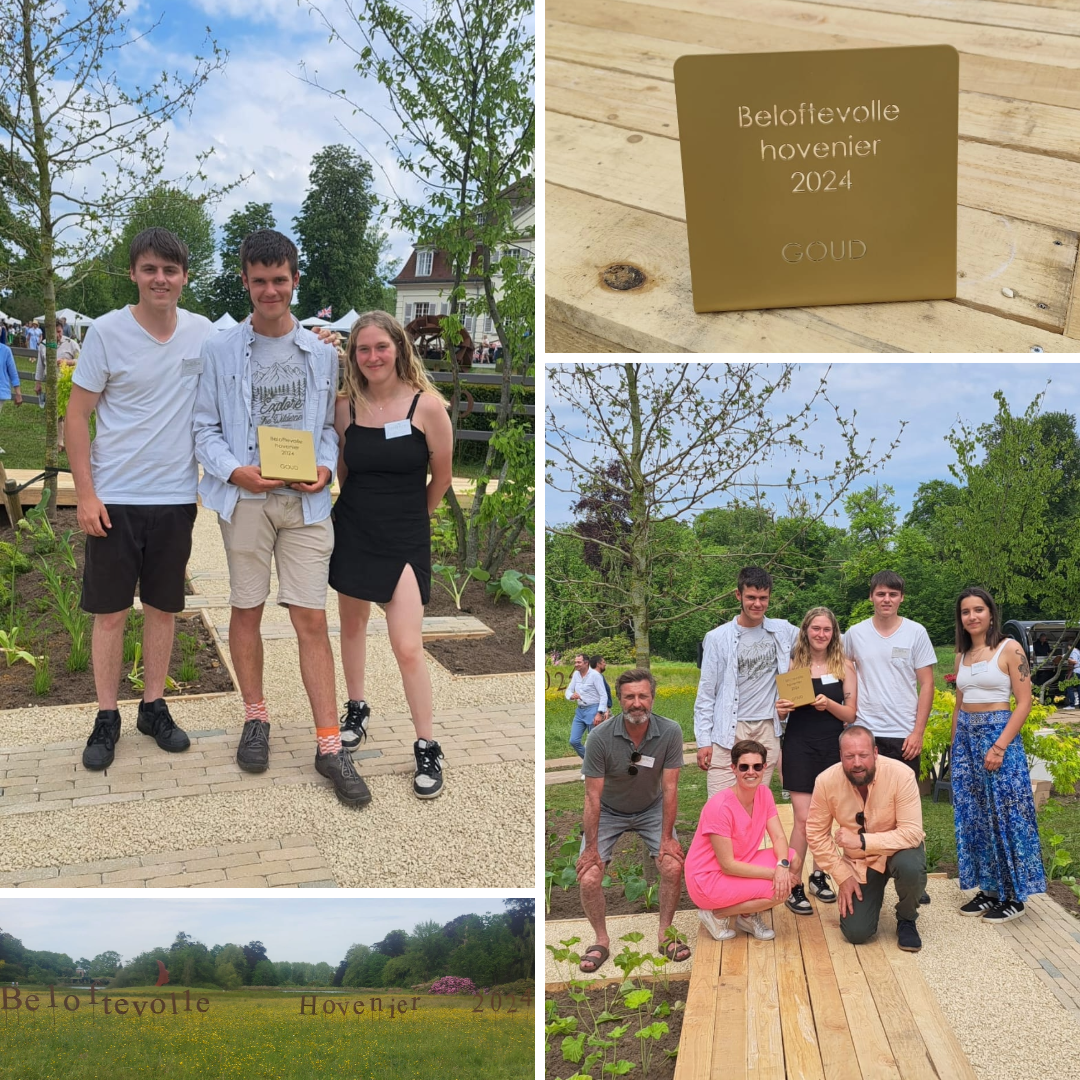
Nice! As I mentioned earlier, I also give talks at horticultural schools. In March, for example, I spoke at PTI in Kortrijk - which was great to do. I’m always struck by how versatile horticulture students must be: they’re expected to ‘know and be able to do a bit of everything.’
Yes, exactly - and that’s sometimes underestimated. It does bother me that certain knowledge is disappearing. Take plant names, for example. The ‘people in Brussels’ apparently don’t see that as very important anymore. But for me, that’s the foundation of everything: if you know the names, you can connect them to when they should be planted, pruned, and so on.
"A landscape gardener not only has to know a lot (about soils, plants, products, …) but he also must be able to do a lot. There are many technical aspects involved too: laying terraces, swimming ponds, electrics for lighting, etc. But you also learn a great deal by doing. And it’s precisely that variety which makes the profession so particularly interesting for me."
A landscape gardener needs a broad skill set, but the field also evolves quickly. How do you stay up to date with new developments and trends?
The first thing I did when I became self-employed was join the professional federation, the BFG-FBEP. They organise, for example, information evenings, which I attend as much as possible. Or interesting excursions. Recently we went to football club Westerlo, where the greenkeeper was able to tell us - and show us - lots of interesting things.
You also learn a lot from conversations with colleagues.
Trade fairs are interesting as well, such as the Nationale Grasdag (National Grass Day) and Agribex. You meet many colleagues, but also the manufacturers with all their new products. Or you can ask questions.
I’m open to all input. And I’m certainly not too proud to ask questions if there are things I don’t know.
And once again, that Green Committee is very important to me. We even have a WhatsApp group where we can ask each other questions. Simple things, like: ‘I need rhododendrons—does anyone know a good supplier?’ And within no time, you’ll get eight answers (laughs).
It’s great to be able to work that way.
Of course, not everyone is equally open to that kind of exchange. But many are - and certainly within the committee. Yes, we’re technically competitors, but we’re also genuine friends. We sometimes get together with our partners and children, and some even go on holiday together (laughs).
"I don’t keep secrets from colleagues either. They can ask me anything: if I can help, I certainly will. Conversely, it’s also great when you can ask someone: ‘I’ve got this problem — how would you do it?’ Right?”
Absolutely, I fully understand. So, are relationships very important to you?
It’s hugely important. For example, at a trade fair I once met Eric Truyers from Advanta, and we immediately clicked. He’s a man with an incredible amount of knowledge, which he’s always happy to share. Now, if I have a question, I just pick up the phone and call him - I get help quickly and properly. For my project in Lebbeke, for instance, I had a question about the soil composition. If he’d been able to, Eric would have even come over personally to take a look (laughs)
Having a good go-to person at your suppliers makes all the difference.
Where do you buy your products?
I often go to Greenex in Hamme. That’s convenient because I can dump my green waste there as well.
But I also buy a lot from Intergrow, via Thomas Van den Haute. Also convenient, because they deliver directly to the site.
Sometimes also from De Witte bvba in Lochristi.
And where do you source your plant material?
That really depends on the project. It’s about assessing what I need at that moment and which supplier can provide it.
But I work more often with Peter Rimbaut in Schellebelle and Calle-Plant in Wetteren. The latter is also a sponsor of the skills competition I mentioned.
For very large trees I often cross the border to the Netherlands to have a look there.
One of my preferred questions is: what is your favourite plant or tree?
I find a Zelkova very beautiful. It’s a tree in the elm family.
But also a Magnolia grandiflora or Bull Bay. There are lots of species and hybrids.
And I’m a fan, on the one hand of the Ginkgo or Japanese maidenhair tree - Ginkgo biloba - and on the other of Cornus kousa (Japanese flowering dogwood).

The ‘problem’ nowadays is that people often choose native trees such as maples, birches, or pedunculate oaks. I understand the reasoning behind that, of course - but I also think there are other trees out there that are even more beautiful (laughs).
In my plant choices I always try to ensure some blossom in spring, foliage in summer, and then a lovely autumn colour.
Do you see climate change influencing the choice of trees and shrubs?
Well, what I notice most is that people often go for the same plants - holm oaks, for example. They see something on social media and want it too. Clients usually ask for two things: first, plenty of privacy - no overlooking. And second, as little maintenance as possible. That’s why holm oaks have become such a popular choice
And so people often end up with the same things. I do try to offer a bit of counterbalance (laughs): otherwise everything ends up looking the same.
The biggest challenge is water management - and in fact, it already is. How can we make sure plants get enough water in summer, while in winter ensuring that excess water can drain away properly?
That’s why the right soil and soil cultivation are very important. And products such as TerraCottem.
How did you first come into contact with TerraCottem?
I think I discovered it at a trade fair. It seemed interesting to me because I often work on dry soils. A product that can retain water: that’s exactly what I needed (laughs)!
Do you use TerraCottem often?
Yes, I use it very often - especially here in the region, where the soils are mostly sandy. When laying lawns, I almost always mix in TerraCottem as standard, particularly in gardens without irrigation systems.
I sometimes notice that my prices are a bit higher than some others. But I refuse to compromise on quality just to be cheaper.
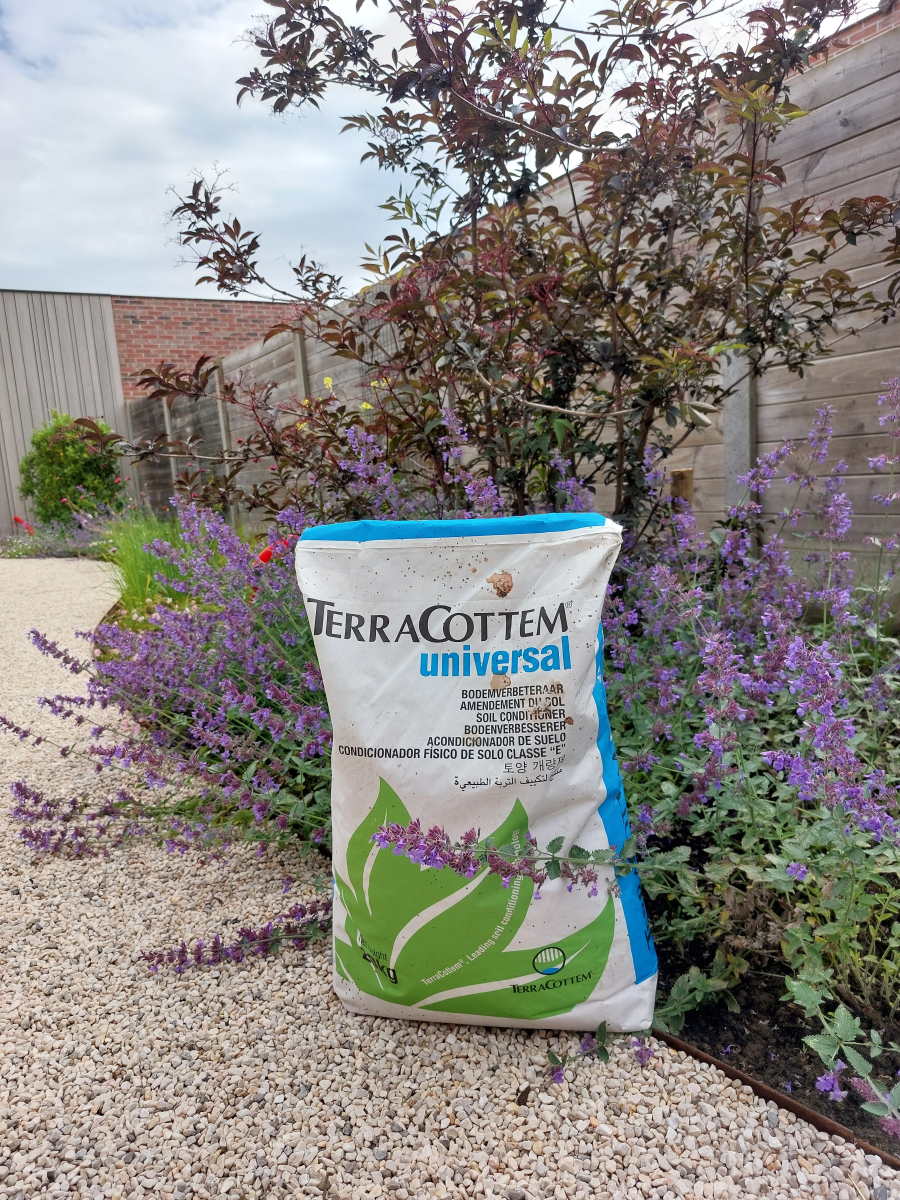
Who decides which products are used: is it the client who specifically asks for something, or you as the landscaper who makes a recommendation?
For lawn installation I always start from a soil analysis. Measuring is knowing. That €100 is very easily earned back if you then take the right steps and use the recommended products.
On the basis of that analysis I choose which products are needed, whether or not after consulting the supplier(s).
Once you know that, you can make a cost estimate for the client. In theory, they could still say: ‘I don’t want this or that.’ But in practice, that rarely happens. On the one hand, clients often don’t have detailed knowledge about these products. And on the other - very importantly - there’s trust: they believe it’s necessary and adds real value.
I never recommend things that aren’t needed. I just want to deliver quality. And hand over projects that remain beautiful in the long term. The ‘problem’ sometimes is that the things we recommend as landscapers aren’t immediately visible. Why, for example, deep digging? Why, for example, use TerraCottem? I always compare it to a concrete foundation: you can’t see the steel reinforcement mesh either, can you, but it’s absolutely essential!
Which TerraCottem soil conditioners do you use?
- For lawns, mostly TerraCottem turf.
- For my plantings, TerraCottem arbor.
- And if a project includes both lawn installation and planting, I opt for TerraCottem universal, which I also use in containers.
On major projects, I make it standard practice to use TerraCottem.
I also take your sample jars with me to clients - it really helps when people can see and feel the product, as it makes the story much easier to explain.
And fun fact: in the Green Young Entrepreneurship Committee knowledge quiz, there’s often even a question about the correct TerraCottem dosage (laughs).
Do you have a particular style, Bert?
No, not really. It really depends on what the client wants. I’ve created modern, sleek gardens. But also rural ones.
Are there any projects you’d particularly like to highlight?
Yes, ten years ago I won a silver medal in the “Vlaamse Tuinaannemer” (Flemish Landscaping Contractor) competition.
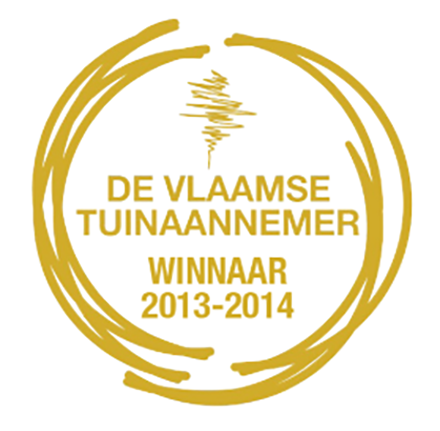
It was a small city garden here in Waasmunster.
This year I want to enter that competition again, once more with a garden in Waasmunster.
I’m currently working on a project in Lebbeke, where TerraCottem will soon be incorporated for both the lawn and the planting. We’ll also be adding a few large trees.
This project is also worth mentioning, right in the heart of Ghent.
My first conversations with the client go back about five years. At the time, it was meant to be just a ‘small project.’ The old townhouse had to be completely renovated, and the inner garden fully redesigned. One condition was clear: the garden had to include a swimming pond—‘otherwise the children wouldn’t want to move there’ (laughs).
Two years ago, we created and developed the garden plan, and since then we’ve been busy bringing it to life:

And very satisfied with the end result:

And maybe a fun little anecdote to wrap things up (winks).
At a GP practice, the doctor asked for low-maintenance planting that also had to be inexpensive. The timing wasn’t ideal - it was already mid-June - so the only real solution was to create a wildflower meadow. We prepared the soil, of course added TerraCottem (winks), and sowed the flowers. At the end of summer, I happened to bump into the doctor, who was absolutely delighted: ‘Clients keep telling us how beautiful that wildflower meadow is.’ Moments like that are exactly why we do what we do (proud smile).
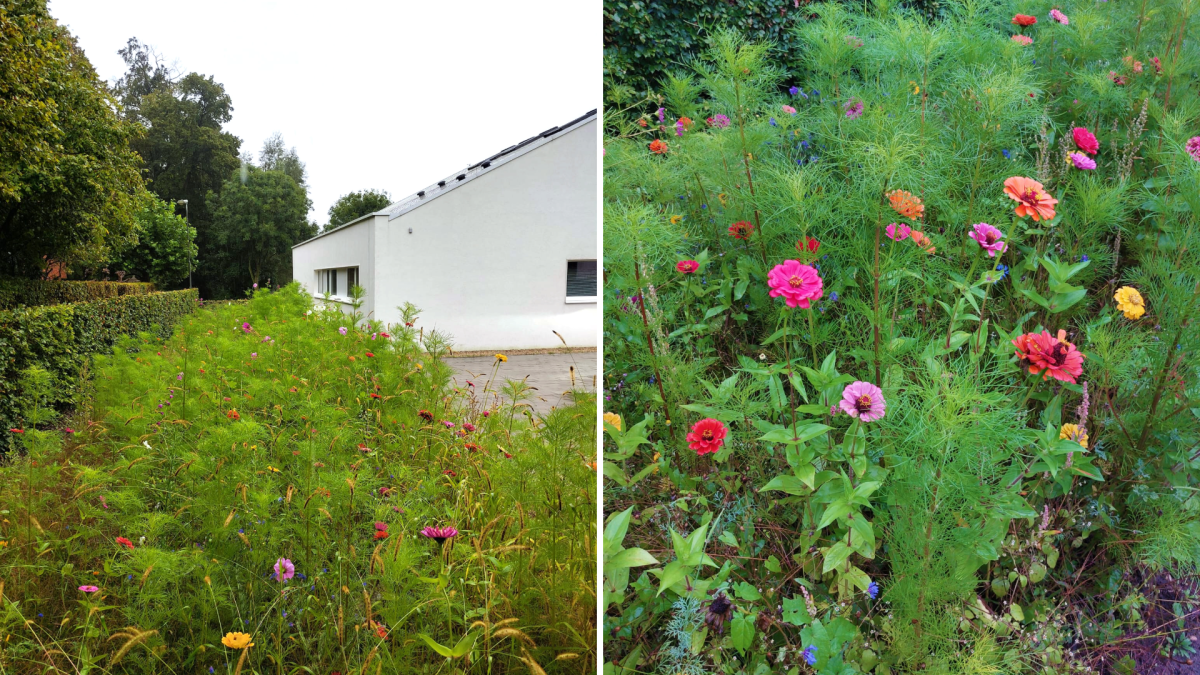
To conclude, do you have a tip for the readers?
My golden tip is:
"Invest in your soil - that’s where everything begins. If the soil isn’t right from the start, the project won’t succeed. It’s tempting to save on what you can’t see, but that “invisible” layer is the foundation of everything that follows."
More information about Tuinen Bert Bauwens?
TUINEN BERT BAUWENS
Warandestraat 12
9250 Waasmunster, Belgium
T: 052/46.21.73
E: info@tuinenbertbauwens.be
W: www.tuinenbertbauwens.be
If you know someone who would also like to read this article, feel free to copy the link and share.
Would you like to be in the spotlight too?
You can!
Send a quick email to marketing@terracottem.be and we will schedule an online meeting together.
Would you also like to use TerraCottem in your projects?
Let's ConnectWould you also like to use TerraCottem in your projects?
Let's ConnectTerraCottem Intl. SL
Apartado de Correos 4511190 Benalup (Cádiz)Spain


